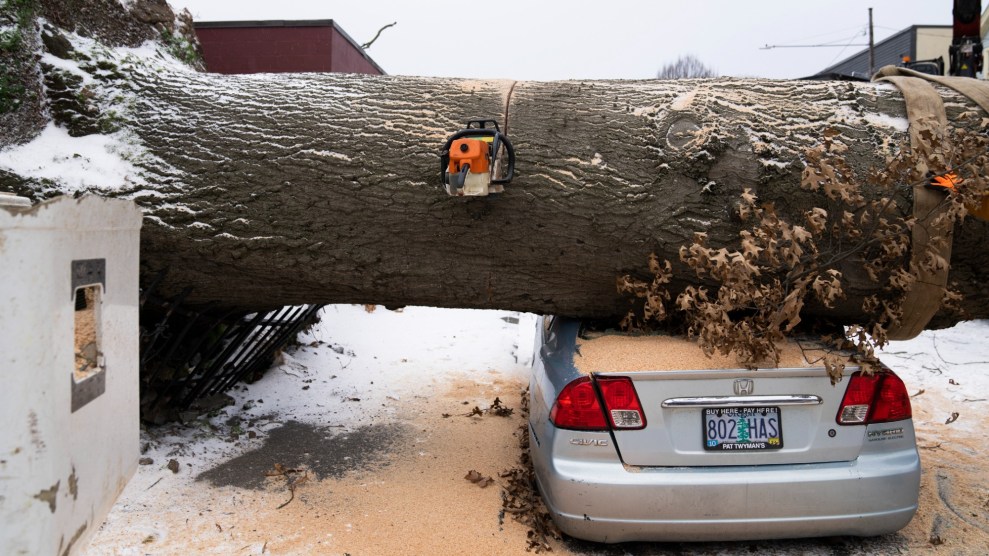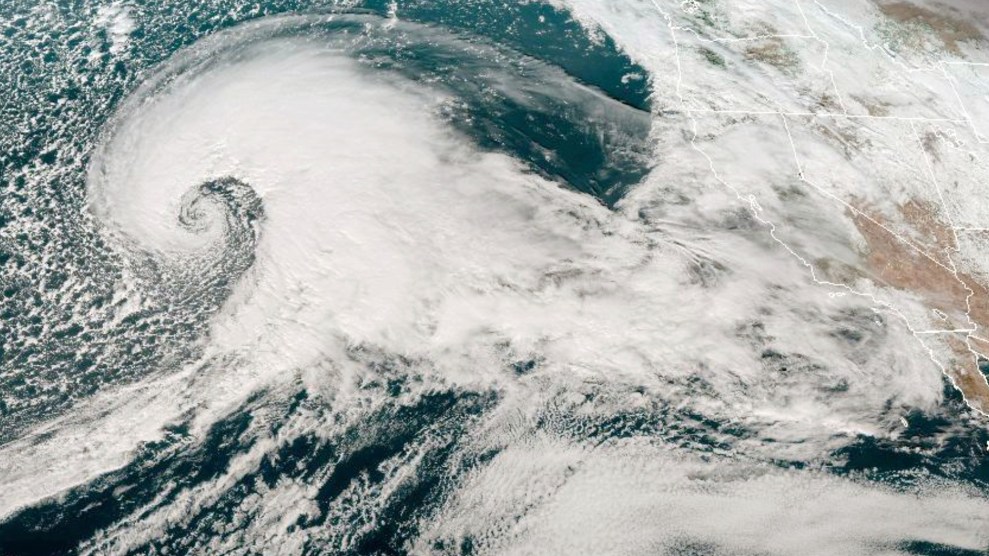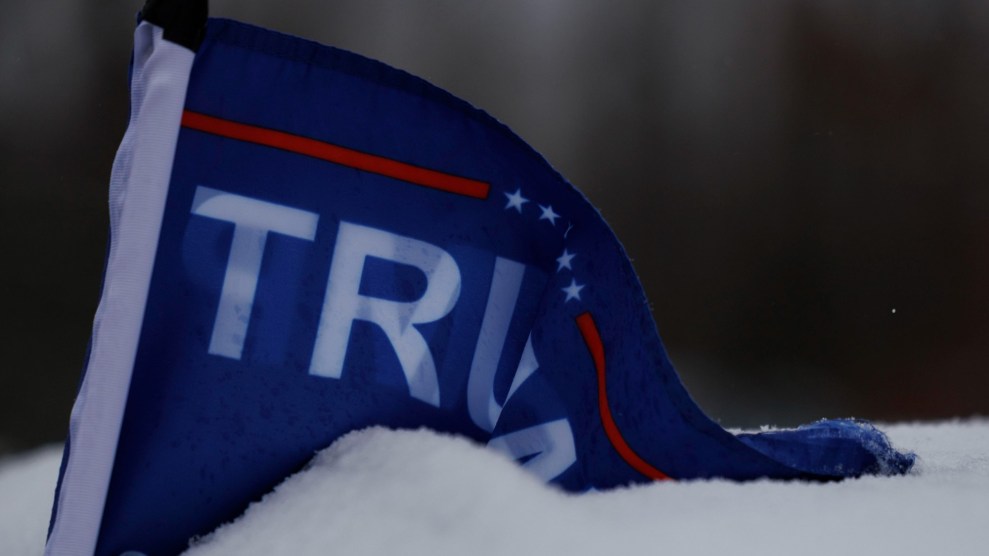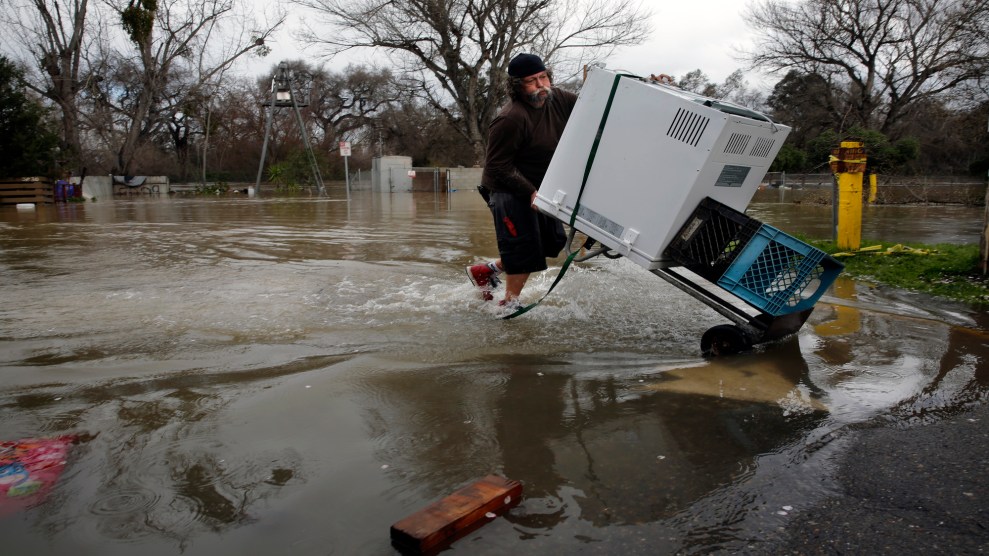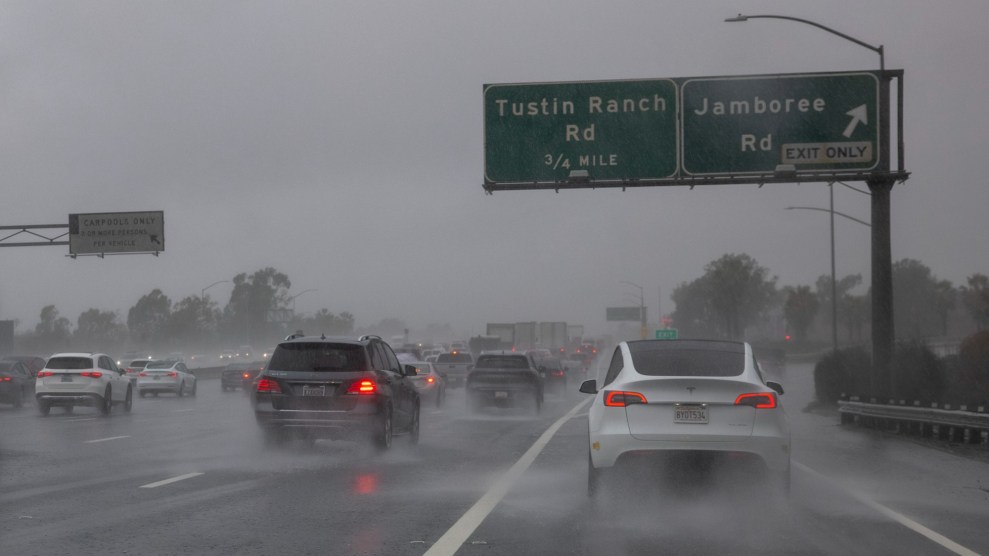
Record rainfall in early February 2024 leaves over 150,000 Californians without power.Ruaridh Stewart / ZUMA
This story was originally published by the Guardian and is reproduced here as part of the Climate Desk collaboration.
The US has just experienced its hottest-ever winter, with record-breaking temperatures driving away snow and ice and causing the coldest months to feel bizarrely balmy in many parts of the country.
Swathes of the lower 48 states had a “lost” winter, with many of the coldest winter states—New York, Vermont, North Dakota, Minnesota, Wisconsin, Iowa, Michigan, and New Hampshire—all setting new record heat levels for the season, which concluded at the end of February, according to the National Oceanic and Atmospheric Administration (NOAA).
Overall, the winter was 5.4 degrees Fahrenheit (3 degrees Celsius) hotter than the long-term average, a huge 0.8 degrees Fahrenheit (0.4 degrees Celsius) increase on the previous record set in the winter of 2015-2016. The US hasn’t had a warmer winter in 130 years of record keeping, and possibly prior to this too.
“It was quite a jump on the previous record—it wasn’t a photo finish, it was a decisive new record,” said Karin Gleason, chief of the monitoring section at Noaa’s National Centers for Environmental Information.
Instead of snow, many regions got rain, with the winter coming in as one of the wettest on record, particularly in the US West, which saw a series of atmospheric rivers hit during February. Los Angeles received three times its average rainfall during February, resulting in the wettest February in decades for the city.
Average temperatures are rising year-round, due to climate change caused by the burning of fossil fuels, but the data shows that the coldest regions, and the coldest times of year, are generally warming at the fastest rates of all, according to Gleason.
“We will still have cold weather in the winter, but this year we just had one real episode of cold weather the rest of it was very mild,” she said. “The overall trend is that we are trending to warmer winters.”
It’s not just the US – February was the hottest such month ever recorded globally, continuing a streak of nine successive months that have set new temperature records, according to the Copernicus Climate Change Service.
“We should expect to continue to break heat records year after year until carbon emissions reach zero,” said Michael Mann, a climate scientist at the University of Pennsylvania. “So this is once again a reminder of the urgency in taking action on climate.”
The record heat this winter manifested itself in a number of ways, including:
A midwest heat patch
A map of the winter warmth shows the biggest temperature increases were centered upon the US upper midwest, one of the coldest areas of the US that typically enjoys bountiful snow and ice at this time of year. Minnesota was 2.7 degrees Fahrenheit (1.5 degrees Celsius) hotter than its previous warmest winter, Wisconsin beat its record by 2.2 degrees Fahrenheit (1.2 degrees Celsius) and Michigan by 1.6 degrees Fahrenheit (0.8 degrees Celsius).
“It really was a winter to remember for that part of the country,” said Gleason.
The high temperatures caused many mountains to lack snow, impacting skiers and snowboarders, while ice receded away from lakes and ponds. People may well have saved money on their heating bills this winter, but the milder temperatures could cause broader knock-on effects, such as a boom in disease-carrying pests that are usually killed off by the cold.
Virtually no ice on the Great Lakes
The Great Lakes region is known for its icy winters, but amid the unseasonably warm temperatures, much of the region has been virtually ice-free this winter.
The Great Lakes are currently at an average of 1.2% ice coverage, according to Bryan Mroczka, physical scientist at Noaa’s Great Lakes environmental research laboratory. That’s the lowest extent in 50 years of record keeping.
Average ice cover for mid-March is between 40-45% for the Great Lakes. But right now, two of the Great Lakes—Erie and Ontario—all currently have “zero ice”, and the other three “are all at record lows for the date”, he said.
Ice levels have been low all winter. From January 1st to March 7th this year, ice coverage across all five Great Lakes averaged just 5.6%, according to the lab’s data—the lowest level since record-keeping began in 1973.
The lack of ice has had cascading effects for communities and economies. Areas downwind of the Great Lakes, for instance, had some of the greatest snowfall deficits of the year due to a lack of lake-effect snow—a phenomenon that occurs when cold air moves across the open waters of the Great Lakes and picks up moisture
State officials also called off the well-known Black Lake winter sturgeon fishing season this year, citing unsafe conditions on thin ice. Authorities also cancelled this year’s Vasa ski race in Michigan—one of the largest cross-country ski races in the US. And the UP 200 dog sled race, which was set to begin February 15th in the state, was also canceled for the second straight year amid warm conditions.
The lack of ice also took a toll on shipping schedules, which depend on predictable lake conditions, and on some marine life that use the ice for protection from predators during the winter, NOAA said.
Warmer air temperatures are strongly correlated with lower ice extent. Though coverage has varied over the past 50 years, the amount of coverage has been trending downward.
The Great Lakes’ ice season runs through March, so it’s still possible for ice to accumulate on the bodies of water as of arctic air to reach the region, Noaa says. But those potential future frigid blasts are more likely to be short-lived, and without a major shift in weather patterns, the season’s ice is unlikely to break from its below-average trend.
Maple syrup season came early
Many communities in the northeast and midwest look forward to maple syrup season each year. But locals know tapping trees for syrup requires a delicate set of climate conditions to strike—temperatures must be above freezing during the day, but below freezing overnight.
As such, maple syrup production doesn’t traditionally begin until late winter or early spring, but amid the climate crisis, the season is often beginning earlier. This year, producers in Massachusetts, Pennsylvania, and Wisconsin all began production weeks ahead of normal—in some cases, as early as January.
In addition to beginning earlier, there is evidence that maple syrup season is getting shorter amid the climate crisis. As a result, some producers are seeing lower volumes of syrup overall. Data show the trend is expected to continue.
Fire and tornados
February was the third warmest such month recorded in the US and it saw the eruption of the Smokehouse Creek wildfire, the largest wildfire in Texas history that has burned through more than a million acres so far. Scientists have warned that rising temperatures are fueling wildfire risk.
More unusually, the warm temperatures even caused tornadoes to form in parts of the Midwest. The warmth mixed with a cold front to stir the storms, with tornadoes in Iowa and Illinois, while Wisconsin saw its first February tornado on record.
